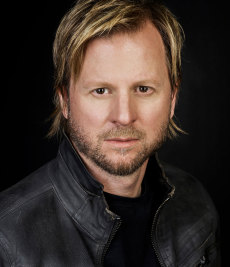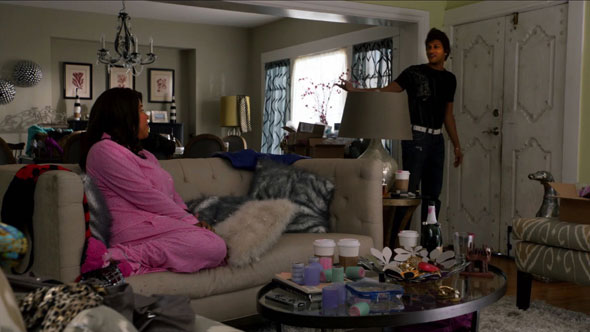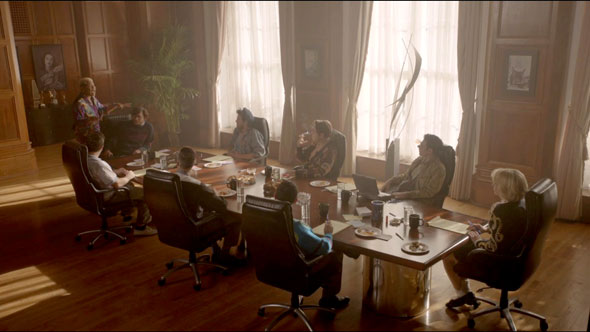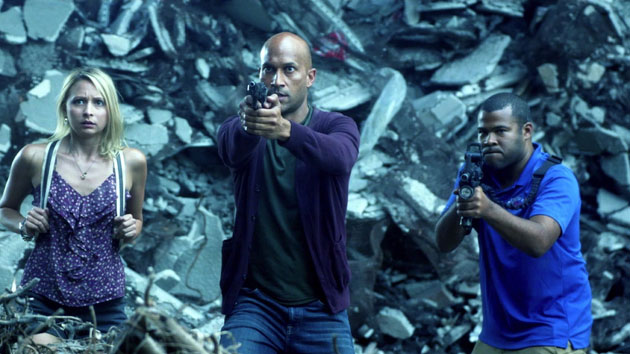
On Art-School Education, His Favorite Final-Season Sketches, and Keeping the Team Together
"Leave 'em wanting more" is a showbiz mantra — even if it's not often followed. TV shows and movie franchises often linger until they exhaust their creative possibilities and wear out their welcome with audiences. But when Jordan Peele and Keegan-Michael Key ended their Comedy Central sketch show Key & Peele last year, they went out on top of their game. In fact, K&P earned an Outstanding Variety Sketch Series Emmy last night for its fifth and final season, and the show is set to go down in history as a sketch-comedy classic.
A big part of the show's success is its absolute commitment to its various comic premises — everything from make-up and hair to cinematography and set decoration worked in concert to conjure settings ranging from ordinary (a high-school classroom, a hotel cafeteria) to fanciful (the colorful backlot of the musical Negrotown or a bombed-out L.A. during an alien invasion) and absurd (a mafia surprise party turned slow-mo Brian De Palma-style shootout). In the thick of it all was production designer Gary Kordan, whose team worked to bring together every sketch in every episode on insanely tight television deadlines. Kordan's work won the Art Directors Guild award this year for Excellence in Production Design and was nominated for an Emmy for Outstanding Production Design for a Variety, Nonfiction, Reality, or Reality Competition series. StudioDaily caught up with him during a break in shooting to learn about his career, the importance of teamwork, and how Key & Peele mined for comic gold week in and week out.

StudioDaily: What are you working on today?
Gary Kordan: I'm working on an Amazon series, Just Add Magic, at L.A. Center Studios downtown. I did the season 1 pilot and have my whole team on season 2. We get to build a bunch of really creative sets. It's a family show, but it's got magic and other cool stuff in it and Amazon is great. They want it to look like an indie feature film.
Are you able to work with the same team on different projects?
I have been with my core people for about 10 years — that's the art director, set decorator, graphic designer, prop master, lead man, even drivers. We're a family. When I'm hired on a show as production designer, it's written into my contract that I have crew approval. That way I know I can deliver the look the project deserves. We do a dozen shows a year, sometimes, between series and pilots and presentations and favors for people and weekend shoots, things like that. We're like a crazy circus. We come to town, set up shop, do a great job, close up shop, and drive to the next lot to do the next project. We're at each other's weddings, birthday parties, and family events on the weekends. In the art department, you're spending 60 or 70 hours a week at work, you're texting through the night and calling each other on the weekends to make sure things are getting done. These are the people who mean the most to you, and you have the utmost expectations for their work. And you're blown away by what they accomplish.
What's your background like, and how did you become a production designer? Did you go to school for this?
Ever since I was a kid, I was churning through as many drawings as possible. I taught myself to draw by copying photographs of Pat Benatar or Heart — rock stars or famous celebrities. It was apparent by the time I got to high school that I would be going to art school and not a more academic type of environment. I applied to and got into the School of Visual Arts in New York City, and I moved there right after high school. That was a great experience, but I had no idea that working TV, film and theater was even an option. It wasn't in my wheelhouse, and no one introduced me to that. I was studying illustration and fine arts, thinking I would be an illustrator, like in Mad Men, working on ad campaigns. It wasn't until my sophomore year when a class was canceled and I was roaming the halls that I saw a flyer saying interns were needed at CBS. A light bulb went on in my head. That sounded like a great place for me.
I went in for the interview and got the job on The Joan Rivers Show. Because most everyone there as an intern or P.A. was out of a communications school, I stood out as the kid from art school. Quickly, Joan and the producers were asking me to work in the art department on specialty props, signage, last-minute book covers, things like that. And I got the bug. From there, people would ask, "Do you do off-Broadway sets?" And I would say yes. "Do you do satellite media tour sets?" Yes. "Do you do pilots?" Yes. I said yes to everything, not knowing how to do anything, and learned by putting my feet in the fire. I had 10 solid years in New York of doing whatever job in an art department I could, which led to running my own departments. I moved to L.A. and never looked back, and since 1992 I've been working in TV, in comedy, as a production designer or art director non-stop.
And it was almost an accident that you discovered this career path was even possible.
In college and high school, no one ever said, "You could be a production designer." They weren't supportive at the SVA either. At that time, it was before Illustrator and Photoshop and things like that, and you were either an illustrator for magazines and books, or a fine artist with a loft downtown doing oil paintings, or a photographer or filmmaker. There wasn't a division saying you could design sets for theater and film. In fact, I didn't finish. I got an internship in the summer of my junior year, in the fall I was offered a job, and so I didn't go back to college. It was a gamble that paid off.

You had to come up with multiple sets for every episode of Key & Peele. What was the schedule like for accomplishing that?
The schedule was bonkers. We would be handed a packet of maybe 90 sketches in a binder, and we had a few weeks to prep them. Then, we would shoot seven weeks straight, two sketches a day, 10 sketches a week, week after week after week, all on location on sound stages, in parks, in bars, on sets I would build wherever we were shooting, all over L.A. We should shoot with a 7 a.m. call time, and often the art department had already been there for hours. We would shoot from 7 to 1, then have lunch, and then do a different sketch. So that was one day's work, two sketches. And we did that day after day after day, week after week after week until you basically dropped.
It's impressive that you worked at that pace for so long.
The reason it worked the way it did was the key crew was together since day one. Nobody left the show. There was no replacement of the director, the DP, or the production designer. Everyone had a mission, and we were trying to impress each other. By the time the last season came about, we were a finely oiled machine that wasn't going to hold back any more. I'm so proud of everything we did on that show — not only the way it looked, but that we had the same department heads and the same crew for five years.
Remember, Key & Peele was only a four-month job for us. There were eight more months that you could get booked on a big show for CBS or HBO and not come back. But we all made sure our calendars were open, even if we would pass on other projects. And I feel like it shows. And on the Comedy Central budget? It's not like we got more money than other shows. It's just that we decided to make every day cinematic and work as hard as we could to do that. I'm so happy that people noticed that, because you aren't necessarily looking at Comedy Central for Emmy Awards.
What were some of the biggest headaches you remember?
Every single sketch that you saw on Key & Peele caused me and everyone else ulcers. First of all, it's logistics. We know you wrote "pirate chantey" or "1980s aerobics set." But we have to figure out how to do them on Tuesday in Santa Clarita in the middle of a park. What warehouse is close, and where can we build it and load in and load out and move on to downtown L.A. the next day? Every sketch was a headache. We weren't based on a soundstage. It was more like, "Well, we're going to be in Long Beach and there is one restaurant we can use, but it has to be 70s-themed, and we have three hours to prep, and we have to be out the same day." That kind of stress happened with every sketch.
So when you start out with that binder, what's your process for organizing your thoughts and breaking down the challenges?
I get everybody I can pulling as much visual research as possible online — historical photos, Pinterest boards. Each sketch would have maybe 50 to 60 visual references that I would pare down to the look I was going for, and those would all be printed out and pasted to the walls. I would take over the production office with hundreds of photos broken down by sketch. That way we could let it sink in and be absorbed, and get ideas from everyone. I could grab an executive producer or Jordan and say, "What do you think?" And I was hoping to hear, "We love it." Boom. That's an approval. And then we start painting flats and stuff like that. And that's every single sketch, whether it's a simple restaurant scene or a scene set in the park.
How did you sleep at night, knowing that you had to go through the same uncertain routine again every single day?
I sleep at night because I have such an unbelievably strong team. No one forgets or says, "Oops." It's about knowing your prop master and your set decorator and your construction foreman all have lists and they know what they're doing. It takes the pressure off. You're hoping the producers love the way it looks, and you're doing it within a budget that's not going to get you fired. But it doesn't all rest on my shoulders. There is a strong dilineation of duties in the art department. And when you've been doing it long enough, you know you can count on them, no matter what. If the construction department forgets to load in at 4 a.m., that shoot can't happen that day and production is eating a half-day of schedule, with tens of thousands of dollars lost. So there is no opportunity for "I forgot" or "I slept in."
Can you name a sketch that you're exceptionally proud of, where everything came together despite a high level of difficulty?
"Pirate Chantey" was for me the best representation of what the art department, costumes, the DP, lighting, props, make-up and hair can do with no money and no time. We found a restaurant in Marina Del Rey where we built all these walls and other elements and brought in set dressing. The trucks were there at 4 a.m. and the locks weren't open yet. The crew was showing up at 7 a.m., so we cut the locks of the restaurant and got into the space and started building. All the elements are going up and costumes and crew and everyone else start showing up, and around 9:30 in the morning when the first shot was going up and everything was lit and people were looking at monitors, we were floored. We were blown away at how it looked. We had all been so busy up until that point that none of us — we weren't able to sit down in a room together and discuss it in detail. We just all brought it, hoping it would work, knowing it would work, and it did.
It's one of my favorite sketches and one of the best-looking ones we did. The funny thing is, the budget on "Pirate Chantey" was no different than any of the other sketches. But we figured out how to do it and make it look like that. And it was just another day. Shoot it, and move on to the next.
Did you enjoy this article? Sign up to receive the StudioDaily Fix eletter containing the latest stories, including news, videos, interviews, reviews and more.









